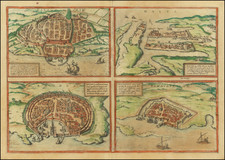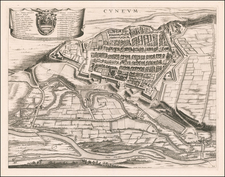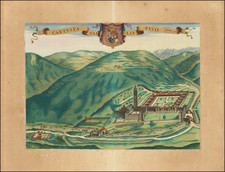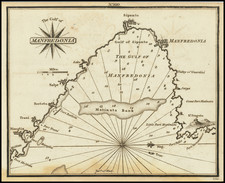Detailed plan of Lucca, from Merian's Neuwe Archontologica Cosmica . . ., published in 1638.
The town plan of Lucca in 1640 is a captivating depiction of Renaissance Italy, illustrating the harmonious blend of medieval fortifications and the burgeoning influence of the Renaissance architectural style. Lucca's town plan is an emblem of its storied past, rich in both culture and warfare.
Perhaps the most distinctive feature of Lucca, readily visible in this plan, is the imposing fortified walls that envelop the town. These walls narrate tales of centuries of political upheaval, invasions, and the intrinsic desire of the Lucchesi to safeguard their independence. While the foundations of Lucca's fortifications trace back to Roman times and were later expanded during the medieval period, the 17th century saw these walls being enhanced to adapt to advancements in military technology. Thick enough to withstand cannon fire, and punctuated with bastions at regular intervals, these fortifications represented the cutting edge of defensive architecture.
Complementing the walls was the surrounding moat, a formidable defensive trench that added another layer of protection. This moat, filled with water, acted as a deterrent for invaders, making any assault on the town a daunting task. Beyond its defensive purpose, the moat also added to the aesthetic allure of Lucca, reflecting the town's silhouette and creating a serene contrast with the formidable walls.
Inside the protective embrace of the walls, Lucca in 1640 was a hive of architectural splendor and urban vitality. Cobblestone streets meandered through the town, leading to lively squares or "piazzas" that were the heartbeat of public life. The Piazza dell'Anfiteatro, for instance, built on the remnants of a Roman amphitheater, was a marvel of urban design. Its elliptical shape, accentuated by medieval houses, made it a popular hub for trade and social gatherings.
Among the many architectural jewels of Lucca, the Cathedral of St. Martin (Duomo di San Martino) stood out prominently. A masterpiece of Romanesque style, the cathedral's intricate facade, decorated with delicate carvings and flanked by slender bell towers, was a testament to Lucca's rich religious heritage. The Palazzo Pfanner, with its Baroque influences and pristine gardens, spoke of the affluence and aesthetic sensibilities of Lucca's elite.
Lucca's urban fabric was interspersed with other notable structures - churches that date back to the early Christian era, grand palaces reflecting the affluence of its noble families, and public buildings that served as nerve centers of administration and governance.
Mathaus Merian (1593-1650) was the father of engraver Matthäus the Younger, and of the painter, engraver, and naturalist Maria Sibylla Merian. He was born in Basel, Switzerland and trained in engraving in Zurich. After a time in Nancy, Paris and Strasbourg, he settled in Frankfurt. While there, he worked for Johann Theodor de Bry, the publisher and son of the travel writer. In 1617, he married Maria Magdalena de Bry, Johann Theodor’s daughter. In 1623, Merian took over the de Bry publishing house upon the death of his father-in-law. Merian’s best known works are detailed town views which, due to their accuracy and artistry, form a valuable record of European urban life in the first half of the sixteenth century










![[Brixen, Italy and Lauingen, German] Brixia Tyrolis [and] Laubinga Sveviae](https://storage.googleapis.com/raremaps/img/small/76740.jpg)



